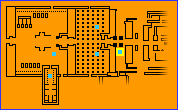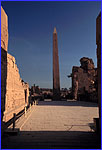
 Between the ruined remains of the Third and Fourth Pylons lies the narrow court
of Amenophis III. He built the Third Pylon, while Tuthmosis I erected the older
Fourth Pylon, which was the front of the temple during his reign. Tuthmosis I
and his grandson Tuthmosis III raised four obelisks in this court, of which
just this one remains.
Between the ruined remains of the Third and Fourth Pylons lies the narrow court
of Amenophis III. He built the Third Pylon, while Tuthmosis I erected the older
Fourth Pylon, which was the front of the temple during his reign. Tuthmosis I
and his grandson Tuthmosis III raised four obelisks in this court, of which
just this one remains.
|  Like an Egyptian Tower of Pisa, the
obelisk of Tuthmosis I features a distinct lean.
Like an Egyptian Tower of Pisa, the
obelisk of Tuthmosis I features a distinct lean.
|
You start by facing north towards the obelisk of Tuthmosis I. If you look
carefully, you can see that it leans slightly to the left. To the right of it—that is, beyond the ruins of the Fourth Pylon—rears the obelisk of the
pharaoh Hatshepsut, the largest still standing in Egypt. After the death of her
father Tuthmosis I in 1495 B.C., Hatshepsut declared herself "king" and ruled
for 20 years, erecting a pair of obelisks here. (The second one toppled, and
its upper portion lies nearby.)
 Hieroglyphic carvings from the Court of Amenophis III.
Hieroglyphic carvings from the Court of Amenophis III.
|
|
As you swing around to the east, you'll see the ruined hulk of the Fourth
Pylon. Due west, you can get a good view of the Great Hypostyle Hall, with the
central, paired rows of 69-foot columns visible between the two palm trees.
Have you noticed the lighting fixtures? They come into play during the
sound-and-light show put on most nights at Karnak Temple.
|
 |




 Between the ruined remains of the Third and Fourth Pylons lies the narrow court
of Amenophis III. He built the Third Pylon, while Tuthmosis I erected the older
Fourth Pylon, which was the front of the temple during his reign. Tuthmosis I
and his grandson Tuthmosis III raised four obelisks in this court, of which
just this one remains.
Between the ruined remains of the Third and Fourth Pylons lies the narrow court
of Amenophis III. He built the Third Pylon, while Tuthmosis I erected the older
Fourth Pylon, which was the front of the temple during his reign. Tuthmosis I
and his grandson Tuthmosis III raised four obelisks in this court, of which
just this one remains. Like an Egyptian Tower of Pisa, the
obelisk of Tuthmosis I features a distinct lean.
Like an Egyptian Tower of Pisa, the
obelisk of Tuthmosis I features a distinct lean.
 Hieroglyphic carvings from the Court of Amenophis III.
Hieroglyphic carvings from the Court of Amenophis III.